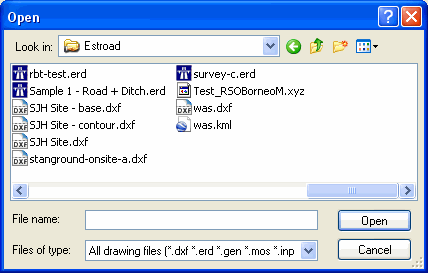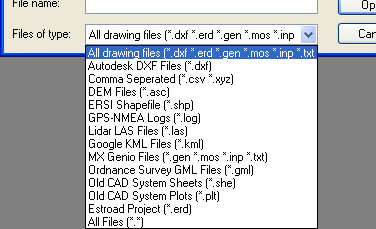You can open an existing 2D or 3D drawing with the File->Open... menu option.
Alternatively, you can click the ![]() toolbar button, or press the Ctrl+O on the keyboard.
toolbar button, or press the Ctrl+O on the keyboard.
You will see the standard window for selecting a file:

Select the file that you want to open.
You can restrict the type of files that you see by using the Files of type: drop-down list.
NOTE: you can enter any kind of URL for the file name. For example http://www.topogx.com/samples/pond.dxf will pull a sample file straight off the web.

The following files types are loaded by TopoGX:
This is an industry standard file format for drawing exchange.
The DXF file format originates from AutoDesk Inc. for their AutoCADTM product line,
but nearly all CAD related software will load or produce a DXF file.
TopoGX will load all versions of DXF file, right through to the latest AutoCAD release.
If you need to load a DWG file rather than a DXF, then you can obtain the free DWG/DXF converter from www.opendwg.org
GML is an alternative format to DXF for digital vector mapping drawings from the UK Ordnance Survey.
GML has the advantage of retaining the coloured regions representing the differing land usages, and so generally
produces a more visually pleasing drawing than the equivalent DXF from the OS.
Note: you can use TopoGX to load a GML file and output as a DXF retaining the same visual appearance.
For Digital Elevation Models. This file format holds height level data in the form of a regular grid of points. There are quite a few different variations on this file format. If you find one that does not load in TOpoGX then please e-mail us at SoftSoft Ltd so that we can add support for it. DEM data is more commonly used in the GIS industry than the CAD industry.
The Shapefile format is used widely in the GIS (Geographic Information Systems) industries. The CAD type data (for example, lines and regions) will be imported from the Shapefile .
This file format originates from the Bentley MXTM system (formerly Moss).
This is the GENIO model format that MX loads and generates.
There is very little feature information in a GENIO file,
but TopoGX tries to assign to different drawing layers based on the 4 character string labels that are present in GENIO files.
The GENIO model will look a lot better in the 3D view of TopoGX than it will in MX (TopoGX will also display it very much faster),
so you may find TopoGX very useful for visualising your MX project data.
This is raw X,Y,Z point data in ASCII format. The coordinates may be comma or space separated. Some DEM files may be in this format. Alternatively, the points may be non-regular point-cloud data.
Lidar systems usually create a cloud of 3D points from the laser ranged surface. TopoGX loads this data and forms the 3D surface model.
Geometry added by Google Earth can be loaded into TopoGX. If the model is within UK lat/lon then it is automatically converted to the equivalent UK Ordnance Survey coordinates.
This is the native file format for TopoGX. An ERD file holds all the project's information, including any data that was loaded from other sources.